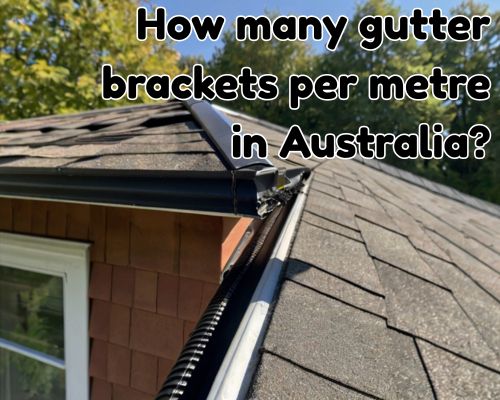
How Many Gutter Brackets Per Metre in Australia? | Melbourne Roof Plumbing Guide
When installing gutters in Melbourne—or anywhere across Australia—one of the most overlooked yet crucial elements is the spacing and quantity of gutter brackets per metre. These small, robust fittings might seem trivial, but they are essential to your gutter system’s structural integrity, especially in a climate like Victoria’s.

So, how many gutter brackets should you install per metre? With Gutter Cleaning Melbourne, let’s unpack the Australian Standards, local requirements, and best practices for optimal gutter installation in Melbourne.
💧 The Standard Answer: How Many Gutter Brackets Per Metre?
According to the Australian Standard AS/NZS 3500.3, the typical recommendation is:
✅ 1 gutter bracket every 1,200 mm (1.2 metres) for residential guttering.
✅ For areas with heavy rainfall or metal gutter systems, this is reduced to every 900 mm (0.9 metres) or less.
✅ In high-wind zones or where leaf guards are installed, spacing can shrink to every 600 mm.
But here’s the catch:
In Melbourne, where weather volatility includes seasonal downpours, hailstorms, and occasional wind gusts strong enough to turn a BBQ into a projectile, spacing brackets more tightly—say, every 800 to 900 mm—is often recommended by experienced roof plumbers and licensed gutter installers.
🏡 Why Gutter Bracket Spacing Matters in Melbourne
1. Climate Resilience
Melbourne is notorious for experiencing “four seasons in a day.” Sudden downpours can overload gutter systems in seconds. Having fewer brackets per metre may lead to sagging, detachment, or water backflow, especially on older fascia boards.
2. Roof Design Factors
Homes in suburbs like Hawthorn, South Yarra, or Brunswick—which often have steep-pitched or heritage-style roofs—require more frequent bracket placement due to the higher volume and speed of runoff.
3. Gutter Material Weight
- Steel or Colorbond gutters weigh more than PVC.
- When combined with debris from overhanging gum trees (common in Melbourne’s eastern suburbs), the stress on brackets multiplies.
💡 Pro tip: In gumleaf-heavy zones like Eltham or Ringwood, pair your brackets with mesh gutter guards to reduce maintenance.
🔧 Best Practices for Installing Gutter Brackets
✔️ Bracket Spacing Guide:
| Gutter Type | Recommended Spacing | Notes |
|---|---|---|
| PVC (Vinyl) Gutters | 1,000–1,200 mm | Light weight, suitable for mild weather |
| Colorbond Steel | 600–900 mm | More durable, ideal for Melbourne’s variable climate |
| Box Gutters | 600 mm | Used for high-capacity systems on commercial roofs |
| Leaf-Guarded Gutters | 600–800 mm | Additional weight requires denser spacing |
✔️ Use Appropriate Bracket Types:
- Fascia brackets – affix directly to timber fascia.
- Suspension brackets – used in suspended systems.
- Overstrap brackets – wrap around the gutter for added security, often used in high-wind suburbs like Point Cook or Frankston.
🧰 Installation Factors that Influence Bracket Spacing
1. Roof Area and Pitch
Larger roofs with steep inclines (think: Toorak mansions or Montmorency split-level homes) shed water faster, increasing pressure on gutters. Tighter bracket spacing compensates for the extra load.
2. Building Height
Double-storey homes catch more wind and water. Installers in Bayside or Essendon often space brackets every 600–800 mm for added resilience.
3. Compliance with Building Codes
Always follow the Victorian Building Authority (VBA) requirements. Improper bracket spacing may void warranties or lead to non-compliance issues during inspections or property sales.
🔍 Common Mistakes to Avoid
- Underestimating weight: Wet debris is heavier than expected.
- Ignoring local council regulations: Some councils like City of Boroondara or Glen Eira may have stricter standards for gutter installations on period homes.
- Mismatching brackets and materials: Don’t use light-duty brackets with heavy-duty steel gutters.
- Poor anchoring: Use corrosion-resistant screws and ensure firm timber fascia anchorage.
🌦️ Melbourne-Specific Considerations
🌀 Wind and Storm Preparedness
Areas like Dandenong Ranges and Mornington Peninsula experience higher wind speeds. Installers often reduce bracket spacing to 600 mm to prevent damage during high-wind events.
🌿 Bushfire Zones
In Bushfire Attack Level (BAL) rated areas, such as outer suburbs near national parks, brackets and gutters must be non-combustible and firmly secured to prevent ember entry or detachment.
💬 Expert Insights from Local Melbourne Roofers
“For Melbourne, we never go beyond 900 mm between gutter brackets. The storm patterns here demand more stability than the minimum code.”
— Jackson Leung, Licensed Roof Plumber, Richmond VIC
“If you’re doing a DIY gutter install in Melbourne, plan for bracket spacing around 800 mm, especially if you’re in older areas with dodgy fascia boards.”
— Anna Corbett, Gutter Replacement Specialist, Preston VIC
📊 Quick Reference: Gutter Bracket Calculator
Here’s a basic calculator based on your gutter length:
Formula:
Total Gutter Length (m) ÷ Spacing (m) = Number of Brackets
Example:
For a 20-metre run with 0.8 m spacing:
20 ÷ 0.8 = 25 brackets
🧠 Always round up to the nearest whole number for extra support.
🏁 Conclusion: So, How Many Gutter Brackets Per Metre in Australia?
In summary, while the general guideline in Australia is 1 bracket per 1.2 metres, Melbourne’s weather and architectural styles call for a more cautious approach:
🔧 Aim for 1 bracket every 0.8–1.0 metres in Melbourne for longevity, compliance, and peace of mind.
By accounting for roof pitch, local council rules, building height, and materials, you can ensure your gutter system stands strong—rain, hail, or shine.
📍Need Help with Gutter Installation in Melbourne?
Whether you’re in Carlton, Brighton, or Box Hill, connect with a licensed Melbourne gutter installer to assess your specific needs. A professional like in Gutter Cleaning Melbourne will help you get the right number of brackets, spacing, and support—while staying compliant with Australian Standards and local building codes.

